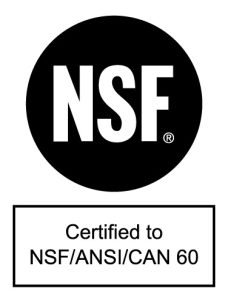Use WELGICIDE CLEANER to:
-
- Removes biofilm produced by iron-reducing and slime-forming bacteria
- Emulsifies oil that has entered the well due to oil-lubricated pumps or accidental spillage.
How to use WELGICIDE CLEANER:

Use about 1/4-lb. of WELGICIDE CLEANER per gallon of water inside the casing. (see table for calculations)
Pour in dry between casing and column pipe. Backwash well to mix and distribute chemical inside column pipe. Add the chemical carefully to the water as considerable heat will be generated when WELGICIDE CLEANER is dissolved in water.
WELGICIDE CLEANER should remain in the well for 24-36 hours and should be agitated every few hours. If a rig is over the hole agitate with a bailer, surge block or other tool. Dry ice can be used to agitate the chemical if rig or pump are not available.
Leave the chemical in the well for 24 to 36 hours.
Pump or bail the hole clean, and then test. Initial water after treatment contains spent chemicals and should be pumped to waste.
For additional chemical penetration and/or to remove “mud-cake”, silt and clay also in the well use WELGICIDE CLEANER with Cotey Chemical’s MUD-NOX.
Do not use WELGICIDE CLEANER on aluminum, magnesium or galvanized pipes.
For best results:
-
-
- Brush the well with the Cotey well cleaning brush prior to chemical treatment. Brushing the well can remove interior screen deposits ensuring more uniform chemical access into the formation.
- Agitate the well with a tight-fitting surge block or other isolation tool (the Cotey WELL CLEANING BRUSH, for example). This dislodges material softened by the chemical treatment and pushes the chemical solution further into areas it may otherwise not be able to reach.
(note: The combination of both chemical and mechanical energy is important for penetrating and removing the plugging material)
-
How to dispose of WELGICIDE CLEANER:
Waste resulting from treatment with WELGICIDE CLEANER is very alkaline, (has a high pH). Waste should therefore not be allowed to contaminate the domestic water supply. Although phosphates are often beneficial to crops, the attendant alkalinity is locally detrimental to the soil, thus waste should not be pumped to cultivated fields unless greatly diluted. Phosphates are also beneficial to fish, but detrimental to lakes and ponds in that they stimulate algae growth. It is therefore recommended that treatment waste be pumped to sewage, barrow ditches for natural evaporation, or to local pits for evaporation and consequent filling provided infiltration will not contaminate a local aquifer. In all cases waste should be thoroughly diluted. (Local, State and Federal regulations should be adhered to.)
CAUTION:
DO NOT MIX WELGICIDE CLEANER WITH OTHER CHEMICALS!
When using this product, wear eye goggles or safety glasses.
WELGICIDE CLEANER is a very strong alkali, thus do not take internally and keep from skin contact. Do not breath fine dust. Skin and eyes should be flushed with water if contact occurs and immediate medical attention should be secured. If ingested, drink large quantities of tea, coffee, or milk with raw eggs if available.
ADD PRODUCT SLOWLY TO THE WELL AS SOLUTION GENERATES CONSIDERABLE HEAT.
WELGICIDE CLEANER is safe on all common metals in well equipment except for prolonged contact with aluminum or galvanized equipment.
WELGICIDE CLEANER and all Cotey products are safe enough to use without pulling the pump.
WELGICIDE CLEANER is packaged in 50-lbs. and 550-lbs. containers.

